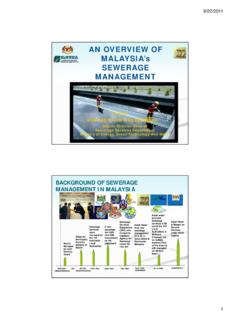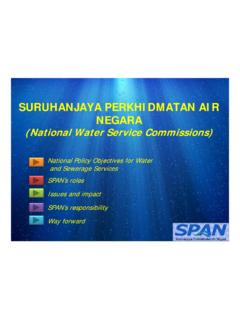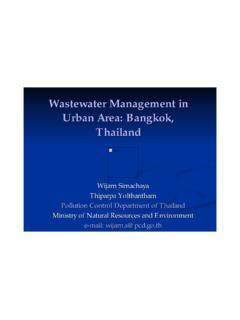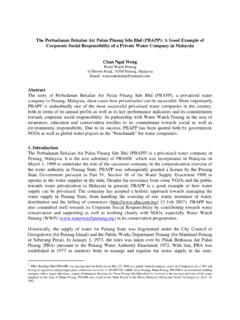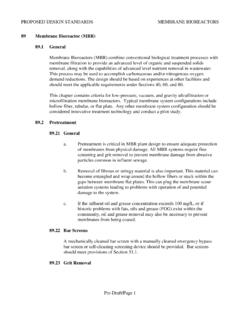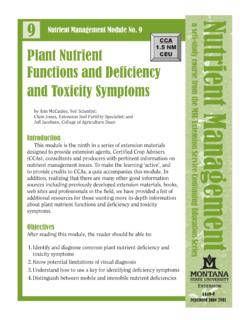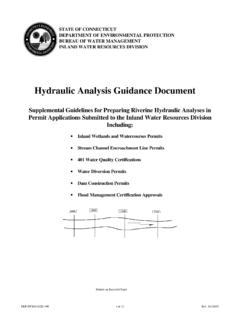Transcription of MALAYSIA’S REQUIREMENTS ON INDUSTRIAL …
1 1 MALAYSIA S REQUIREMENTS ON INDUSTRIAL effluent treatment SYSTEMS-The WEPA Workshop and Annual Meeting18-21 February 2013 Siem Reap, Combodia-byeNFORCEMENT DIVISION DEPARTMENT OF ENVIRONMENT, MALAYSIA Scope of PresentationIntroductionRegulation RequirementsControl Based on Engineering Design of IETSP erformance Monitoring of IETSC ontravention Licence2 Written Notification4 Introduction INDUSTRIAL effluent treatment Systems:any facility including the effluent collection system , designed and constructed for the purpose of reducing the potential of the INDUSTRIAL effluent or mixed effluent to cause pollution. INDUSTRIAL effluent means any waste in the form of liquid or wastewater generated from manufacturing process including the treatment of water for water supply or any activity occurring at any INDUSTRIAL premises;3 INDUSTRIAL effluent treatment SYSTEMS (IETS)Section 4 in INDUSTRIAL effluent Regulation, 2009 (IE2009)*-a premise is required to notify DOE for:New sourcesIncrease in production capacity resulting in increase in effluent quantityIETS upgrading resulting in worsened effluent quality*[written notification requirement to replaces thewritten permission in SIER1979]6 INDUSTRIAL effluent treatment system (IETS)Section 5and Section 6: Specification on IETS -Designand Operation- Needs to comply with the Guidance Document onDesign and Operation (GDDO); Undertaken by professional engineers.
2 IETS must comply with stipulated operationalcharacteristics4 Written Declaration on Design and Construction of IETS(NEW and ALTERED SOURCES OF effluent DISCHARGE)-Declare that the INDUSTRIAL effluent treatment system has been designed and constructed in strict compliance with the minimum REQUIREMENTS and specifications as specified in the Guidance Document by: Owner Engineer responsible for the treatment design process Engineer responsible for the structural design Engineer responsible for the design of mechanical components Engineer responsible for the design of mechanical and electronic components56 Control Based on Engineering Design of IETS12 Engineering Design of IETSC ommon INDUSTRIAL effluent treatment system used in industries in Malaysia 1. Physcio-Chemical treatment Processes Chemical Precipitation Oxidation/reduction Dissolved Air Floatation (DAF)2.
3 Biological treatment Processes Activated Sludge Sequential Batch Reactor Oxidation Ponds Trickling filters Anaerobic Upflow Sludge Blanket (AUSB)713 Engineering Design of IETSC ommon INDUSTRIAL effluent treatment system used in industries in Malaysia 3. Advanced treatment Processes Ion Exchange Activated Carbon Adsorption Filtration 4. treatment of Sludge Sludge drying bed Filter Press Belt press Centrifugal separationEngineering Design of IETS8 Sequential Batch ReactorIndustrial effluent treatment Systems9 Facultative PondFinal discharge BFacultative pondBFacultative pondBAlgae pond BAlgae pond AAlgae pond CFinal discharge A & BFacultative pondCFacultative pondAFacultative pondAFacultative pondCAnaerobic pondBAnaerobic pond CMixing pondOil trapCooling pond10 Oil trapAnaerobic pondMixing pondCooling pondEngineering Design of IETSP onding SystemFacultative pondAlgae pond11 Discharge MonitoringSection 7 monitor the quantity and qualityof effluent discharged on a weekly basisB.
4 Relevant parameters are to be monitored based on guidance given in the Guidance Document on Performance Monitoring (GDPM)C. On line the monthly discharge monitoring report (MDMR) needs to be submitted to DOE on a monthly basisProper Operation of IETS-Section 8 IE2009-to operate and maintain the IETS ingood working condition within theacceptable ranges/characteristicsasspecified in the Guidance Documenton Performance Monitoring12 SECTION 9 IE2009 Operation of Industries and Performance Monitoring of IETS13 WHAT IS PERFORMANCE MONITORING?Handle proper operation and maintenanceProactive& preventive monitoringof certain parameters to provide a diagnostic indicationto ensure that each component of INDUSTRIAL effluent treatment Systemsare operating optimally. Parameters to monitor our health status = health of unit operations/processes of IETSO peration of INDUSTRIAL effluent treatment SystemsAnalytical RequirementsPerformance monitoring is based on in-situ measurementsusing portable equipment or on-line sensorsFinal effluentsamples to follow Standard Methods14 The operation of an IETS needs to be supervised by a competent person (CP)-any person who has been certified by the Director General -on duty at any time of the IETS in operation-monitor all components, unit processes/operations of the IETS*[Nominated CP by premise needs to attend 10 days courseprogram executed by EiMAS, practical training attachement andsubmission a project works before certified as CP by the GD ofDOE]COMPETENT PERSONR egulatory REQUIREMENTS on Performance Monitoring(Section 10 IE2009)
5 Performance Monitoring of Biological Processes3 different types of monitoring parameters:to ensure biological process are functioning pH, DO, and nutrients to provide diagnostic checkon the health status of various unit operations and unit processes MLSS & MLVSS, SVI To indicate overall efficiencyof the treatment system BOD & OxygenDO concentrationof about to mg/L; typically 2 mg/LInsufficient oxygen promotes growth of filamentous organismsaffecting sludge settleabilityusing a portablehand-held DO meter or measured continuously by on-lineDO sensor Sludge Volume Index SVISVI is used as an indication of settling characteristicsof sludge and to determine recirculation ratioPoor settling sludge results in a reduced BOD removal efficiency SVI :<50 excellent,50-100 good,100-150 satisfactory, >150 very poor (bulking of sludge)16 NutrientsMany INDUSTRIAL effluents lack in nutrientsNutrient balanceshould be periodically checked The rule of thumbfor BOD5: N: P ~ 100: 5: 1.
6 Typical signs of nutrient deficiencyare filamentous growth and bulking of activated sludge. Performance Monitoring of Physical and Chemical ProcessesHeavy Metals Removal by Precipitation and Coagulation ReactionsCoagulation and precipitation reactions work best within narrow pH range Solubility of metals is controlled by the solution pH where it is lowest at the point of minimum solubilitypH is the most useful parameter monitored17 Performance Monitoring and Testing Guide for Biological Unit ProcessesActivated SludgePH DailyDODailyMLSSD aily/weekly MLVSSW eekly/monthly OXYGEN UPTAKE Weekly/monthly NUTRIENTS Weekly/monthly SVI Weekly/monthlyPRACTICE OF PERFORMANCE MONITORING the maintenance cultureCultivate self monitoring & regulationEnsure continued optimal performance (TIP-TOP)
7 Of IETS Ensure continued regulatory complianceHelp avoid IETS failureHelp avoid costly recovery actionHelp avoid regulatory enforcement18 SECTION 15 IE2009 Contravention Licence Polluter pay principle Licence to pollute New or Upgrading not compound (RM 2000 each); conviction through court action carries a maximum penalty of RM100,000 PLUS 5 year You Very Much
